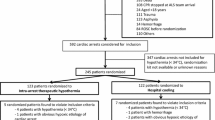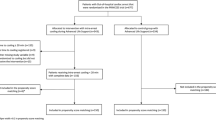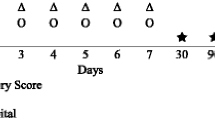Abstract
Introduction
Mild induced hypothermia (MIH) is indicated for comatose survivors of sudden cardiac arrest (SCA) to improve clinical outcome. In this study, we compared the efficacy of two different cooling devices for temperature management in SCA survivors.
Methods
Between April 2008 and August 2009, 80 patients after survived in-hospital (IHCA) and out-of-hospital cardiac arrest (OHCA) were included in this prospective, randomized, single center study. Hypothermia was induced after randomization by either invasive Coolgard® cooling or non-invasive ArcticSun® surface cooling at 33.0 °C core body temperature for 24 h followed by active rewarming. The primary endpoint was defined as the efficacy of both cooling systems, measured by neuron-specific enolase (NSE) levels as a surrogate parameter for brain damage. Secondary efficacy endpoints were the clinical and neurological outcome, time to start of cooling and reaching the target temperature, target temperature-maintenance and hypothermia-associated complications.
Results
NSE at 72 h did not differ significantly between the 2 groups with 16.5 ng/ml, interquartile range 11.8–46.5 in surface-cooled patients versus 19.0 ng/ml, interquartile range 11.0–42.0 in invasive-cooled patients, p = 0.99. Neurological and clinical outcome was similar in both groups. Target temperature of 33.0 °C was maintained more stable in the invasive group (33.0 versus 32.7 °C, p < 0.001). Bleeding complications were more frequent with invasive cooling (n = 17 [43.6 %] versus n = 7 [17.9 %]; p = 0.03).
Conclusion
Invasive cooling has advantages with respect to temperature management over surface cooling; however, did not result in different outcome as measured by NSE release in SCA survivors. Bleeding complications were more frequently encountered by invasive cooling.




Similar content being viewed by others
References
Abou-Chebl A (2004) Technical refinements and drawbacks of a surface cooling technique for the treatment of severe acute ischemic stroke. Neurocrit Care 1(2):131–143
Auer J (2006) Ability of neuron-specific enolase to predict survival to hospital discharge after successful cardiopulmonary resuscitation. CJEM 8(1):13–18
Bernard SA (2002) Treatment of comatose survivors of out-of-hospital cardiac arrest with induced hypothermia. N Engl J Med 346(8):557–563
Booth CM (2004) Is this patient dead, vegetative, or severely neurologically impaired? Assessing outcome for comatose survivors of cardiac arrest. JAMA 291(7):870–879
Chesebro JH (1987) Thrombolysis in myocardial infarction (TIMI) trial, phase I: a comparison between intravenous tissue plasminogen activator and intravenous streptokinase. Clinical findings through hospital discharge. Circulation 76(1):142–154
Einav S (2012) Modeling serum biomarkers S100 beta and neuron-specific enolase as predictors of outcome after out-of-hospital cardiac arrest: an aid to clinical decision making. J Am Coll Cardiol 60(4):304–311
Fogel W (1997) Serum neuron-specific enolase as early predictor of outcome after cardiac arrest. Crit Care Med 25(7):1133–1138
Gillies MA (2010) Therapeutic hypothermia after cardiac arrest: a retrospective comparison of surface and endovascular cooling techniques. Resuscitation 81(9):1117–1122
Haugk M (2007) Feasibility and efficacy of a new non-invasive surface cooling device in post-resuscitation intensive care medicine. Resuscitation 75(1):76–81
Heard KJ (2010) A randomized controlled trial comparing the Arctic Sun to standard cooling for induction of hypothermia after cardiac arrest. Resuscitation 81(1):9–14
Herlitz J (1995) Hospital mortality after out-of-hospital cardiac arrest among patients found in ventricular fibrillation. Resuscitation 29(1):11–21
Holzer M (2005) Hypothermia for neuroprotection after cardiac arrest: systematic review and individual patient data meta-analysis. Crit Care Med 33(2):414–418
Jarrah S (2011) Surface cooling after cardiac arrest: effectiveness, skin safety, and adverse events in routine clinical practice. Neurocrit Care 14(3):382–388
Jennett B, Bond M (1975) Assessment of outcome after severe brain damage. Lancet 1(7905):480–484
Knaus WA (1985) APACHE II: a severity of disease classification system. Crit Care Med 13(10):818–829
Langhelle A (2005) Recommended guidelines for reviewing, reporting, and conducting research on post-resuscitation care: the Utstein style. Resuscitation 66(3):271–283
Libby P (2002) Inflammation and atherosclerosis. Circulation 105(9):1135–1143
Madl C, Holzer M (2004) Brain function after resuscitation from cardiac arrest. Curr Opin Crit Care 10(3):213–217
Martens P (1998) Serum S-100 and neuron-specific enolase for prediction of regaining consciousness after global cerebral ischemia. Stroke 29(11):2363–2366
Meynaar IA (2003) Serum neuron-specific enolase predicts outcome in post-anoxic coma: a prospective cohort study. Intensive Care Med 29(2):189–195
Nielsen N (2011) Adverse events and their relation to mortality in out-of-hospital cardiac arrest patients treated with therapeutic hypothermia. Crit Care Med 39(1):57–64
Nolan JP (2010) European Resuscitation Council Guidelines for Resuscitation 2010 Section 1. Executive summary. Resuscitation 81(10):1219–1276
Peberdy MA (2010) Part 9: post-cardiac arrest care: 2010 American Heart Association Guidelines for Cardiopulmonary Resuscitation and Emergency Cardiovascular Care. Circulation 122(18 Suppl 3):S768–S786
Pfeifer R (2005) Outcome after cardiac arrest: predictive values and limitations of the neuroproteins neuron-specific enolase and protein S-100 and the Glasgow Coma Scale. Resuscitation 65(1):49–55
Rosén H (2001) Serum levels of the brain-derived proteins S-100 and NSE predict long-term outcome after cardiac arrest. Resuscitation 49(2):183–191
Rundgren M (2009) Neuron specific enolase and S-100B as predictors of outcome after cardiac arrest and induced hypothermia. Resuscitation 80(7):784–789
Schoerkhuber W (1999) Time course of serum neuron-specific enolase. A predictor of neurological outcome in patients resuscitated from cardiac arrest. Stroke 30(8):1598–1603
Shinozaki K (2009) S-100B and neuron-specific enolase as predictors of neurological outcome in patients after cardiac arrest and return of spontaneous circulation: a systematic review. Crit Care 13(4):R121
Sterz F (2003) Hypothermia after cardiac arrest: a treatment that works. Curr Opin Crit Care 9(3):205–210
Teasdale G, Jennett B (1974) Assessment of coma and impaired consciousness. A practical scale. Lancet 2(7872):81–84
Tømte Ø (2011) A comparison of intravascular and surface cooling techniques in comatose cardiac arrest survivors. Crit Care Med 39(3):443–449
Wijdicks EFM (2006) Practice parameter: prediction of outcome in comatose survivors after cardiopulmonary resuscitation (an evidence-based review): report of the quality standards subcommittee of the american academy of Neurology. Neurology 67(2):203–210
Zandbergen EGJ (2006) Prediction of poor outcome within the first 3 days of postanoxic coma. Neurology 66(1):62–68
Mild therapeutic hypothermia to improve the neurologic outcome after cardiac arrest. N. Engl. J. Med. 346, 8, 549–556 (2002)
Acknowledgments
This study was supported in part by a research grant from the University of Leipzig-Heart Center. The final manuscript has been approved by all authors. The authors would like to thank Goetz Gelbrich, PhD, for his contribution to the design of this study. We also would like to thank the staff of the Intensive Care Unit of the University of Leipzig-Heart Center.
Conflict of interest
Undine Pittl, MD, and her co-authors have no conflict of interest. On behalf of all authors, the corresponding author states that there is no conflict of interest. None of the authors received any financial support for this study.
Author information
Authors and Affiliations
Corresponding author
Additional information
Trial registration: ClinicalTrials.gov NCT: 00843297.
Rights and permissions
About this article
Cite this article
Pittl, U., Schratter, A., Desch, S. et al. Invasive versus non-invasive cooling after in- and out-of-hospital cardiac arrest: a randomized trial. Clin Res Cardiol 102, 607–614 (2013). https://doi.org/10.1007/s00392-013-0572-3
Received:
Accepted:
Published:
Issue Date:
DOI: https://doi.org/10.1007/s00392-013-0572-3




